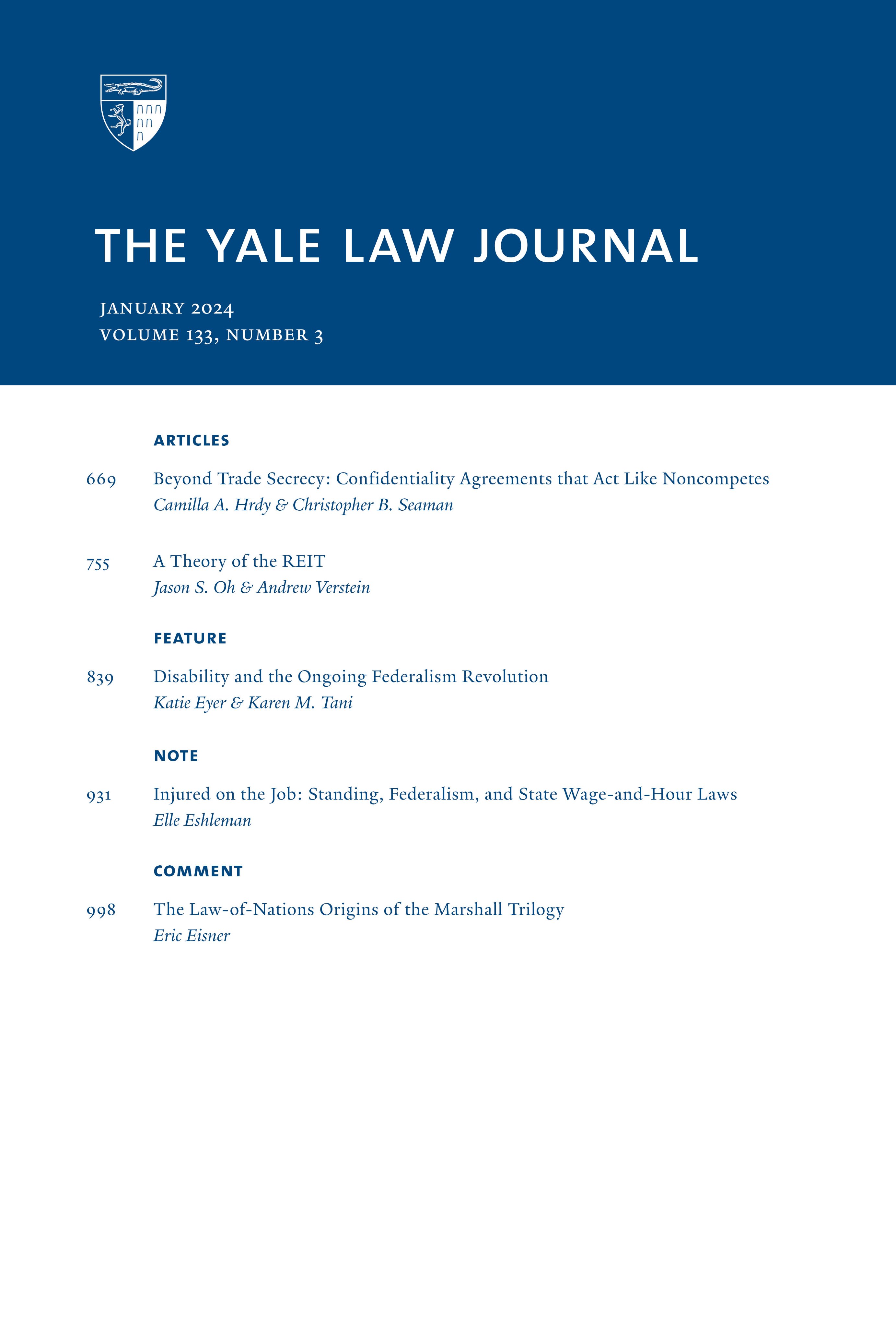The Origins of Judicial Deference to Executive Interpretation
IF 5.2
1区 社会学
Q1 LAW
引用次数: 17
Abstract
Judicial deference to executive statutory interpretation — a doctrine now commonly associated with the Supreme Court’s decision in Chevron v. Natural Resources Defense Council — is one of the central jurisprudential principles in modern American public law. Despite its significance, however, the doctrine’s origins and development are poorly understood. The Court in Chevron claimed that judicial deference’s roots stem back to statutory-interpretation cases from the early Nineteenth Century. Others, by contrast, have sought to locate Chevron’s doctrinal roots in judicial review’s origins in the writ of mandamus. According to the standard narrative, courts in the pre-Chevron era followed a multi-factor and ad hoc approach to issues of judicial deference; there was little theory that explained the body of cases; and the holdings and reasoning of the cases were often contradictory and difficult to rationalize. This Article challenges the standard account. It argues that the Supreme Court in Chevron, and scholarly commentators since, have misidentified Nineteenth Century statutory-interpretation cases applying canons of construction “respecting” contemporaneous and customary interpretation as cases deferring to executive interpretation as such. It further argues that, although the standard for obtaining a writ of mandamus was central to judicial review in the early Republic, statutory developments in the latter half of the Nineteenth Century (significantly, the enactment of general federal-question jurisdiction in 1875) ultimately mooted the relevance of that standard. Finally, it discusses the intellectual challenges to the traditional interpretive framework in the early Twentieth Century; the Supreme Court’s embrace of these intellectual challenges in the early 1940s; and Congress’s attempt in the Administrative Procedure Act’s standard-of-review provision to reject the Court’s interpretive experimentation and corresponding deviation from the traditional canons. The Article thus seeks to establish — contrary to the suggestion in Chevron and recent cases — that there was no rule of statutory construction requiring judicial deference to executive interpretation qua executive interpretation in the early American Republic. And it contends that the governing statute of administrative law — the APA — was intended to codify the traditional interpretive approach and to reject the experimentation of the 1940s Court. Taken together, these conclusions cast doubt on much of the received wisdom on the doctrinal basis for the rule announced in Chevron.司法服从行政解释的起源
司法服从行政法规解释是现代美国公法的核心法理原则之一,这一原则现在通常与最高法院在雪佛龙诉自然资源保护委员会一案中的裁决联系在一起。然而,尽管它意义重大,但人们对它的起源和发展却知之甚少。最高法院在雪佛龙案中声称,司法尊重的根源可以追溯到19世纪早期的法律解释案件。相比之下,其他人则试图将雪佛龙的教义根源定位于司法审查的起源——曼达姆斯令状。根据标准的叙述,前雪佛龙时代的法院遵循一种多因素和特别的方法来处理司法服从问题;几乎没有理论可以解释大部分的案例;而且案件的认定和推理往往相互矛盾,难以理性化。这篇文章对标准说法提出了挑战。它认为,最高法院在雪佛龙案中,以及此后的学术评论人士,错误地将19世纪的法定解释案件认定为“尊重”当时的和习惯的解释,并将其视为服从行政解释的案件。它进一步认为,尽管获得令状的标准是共和国早期司法审查的核心,但19世纪下半叶的法定发展(特别是1875年颁布的一般联邦问题管辖权)最终提出了该标准的相关性。最后,讨论了20世纪初对传统解释框架的智力挑战;最高法院在20世纪40年代早期接受了这些知识挑战;国会试图在《行政程序法》的审查标准条款中拒绝法院的解释性实验和对传统规范的相应偏离。因此,该条试图确立——与雪佛龙案和最近的案件所暗示的相反——在美利坚共和国早期,不存在要求司法服从行政解释的法定解释规则。它认为,行政法律的管理法规——《行政程序法》——旨在编纂传统的解释方法,并拒绝20世纪40年代最高法院的实验。综上所述,这些结论对在雪佛龙案中宣布的规则的教义基础上的许多公认的智慧提出了质疑。
本文章由计算机程序翻译,如有差异,请以英文原文为准。
求助全文
约1分钟内获得全文
求助全文
来源期刊

Yale Law Journal
LAW-
CiteScore
4.50
自引率
6.20%
发文量
0
期刊介绍:
The Yale Law Journal Online is the online companion to The Yale Law Journal. It replaces The Pocket Part, which was the first such companion to be published by a leading law review. YLJ Online will continue The Pocket Part"s mission of augmenting the scholarship printed in The Yale Law Journal by providing original Essays, legal commentaries, responses to articles printed in the Journal, podcast and iTunes University recordings of various pieces, and other works by both established and emerging academics and practitioners.
 求助内容:
求助内容: 应助结果提醒方式:
应助结果提醒方式:


